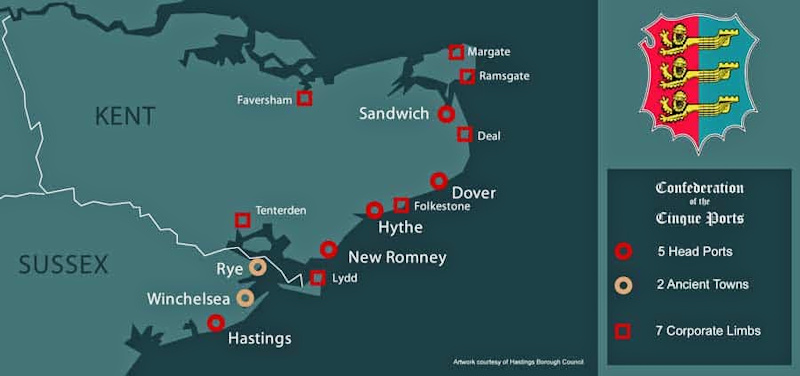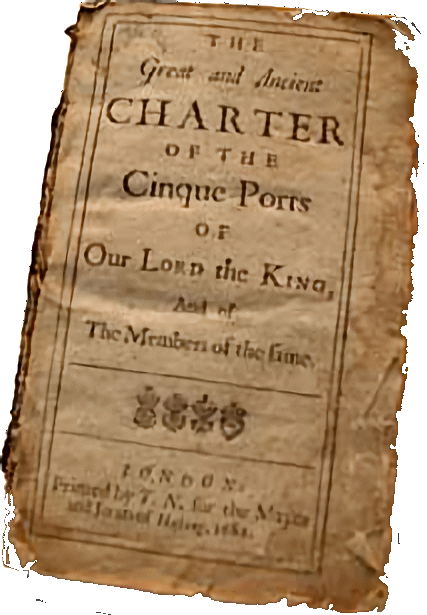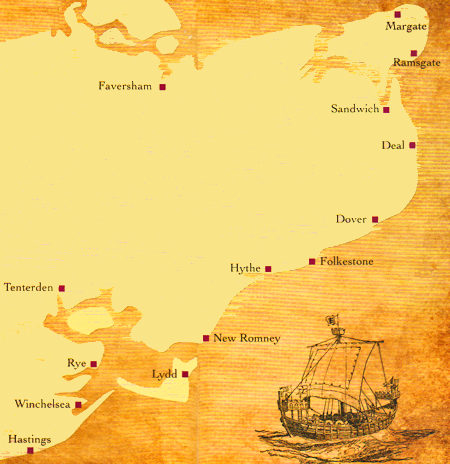Cinque Ports
In the centuries before the Tudor Kings of England first developed a standing navy, the men and ships of the Cinque Ports provided a fleet to meet the military and transportation needs of their Royal masters. With good reason, these small ports have been dubbed the Cradle of the Royal Navy.
The Confederation of Cinque Ports is a historic series of coastal towns in Kent, Sussex and Essex. It was originally formed for military and trade purposes but is now entirely ceremonial. The ports lie at the eastern end of the English Channel, where the crossing to the continent is narrowest. The name is Norman French, meaning "five ports".

The distinctive heraldic emblem
of the Cinque Ports is the front half of a lion joined to the back
of a ship, seen in the coats of arms of several towns, and
also in the heraldic banner (flag) of the Lord Warden of the Cinque Ports
Prior to the 15th Century, England had no permanent navy to defend it from sea-borne aggression. Instead five ports in the South East - the region most vulnerable to invasion - contracted with the Crown to provide a defensive fleet when required.
Royal Charter
A Royal Charter of 1155 established 5 ports on the south coast to maintain ships ready for the Crown in case of need. These ports – Hastings, Sandwich, Dover, Romney and Hythe – became known as the Cinque Ports (from the French word five, but always pronounced ‘sink’ not ‘sank’).
They were granted many freedoms (for example militia service, from market and port tolls) and privileges, the most prized being the right to carry the canopy over the King at the Coronation and the very profitable, running of the international Herring Fair on Yarmouth strand.
As a corporate duty, the chief obligation laid upon the ports was to provide 57 ships for 15 days' service to the king annually, each port fulfilling a proportion of the whole duty. In return the towns received the following privileges:
Exemption from tax and tolls; self-government; permission to levy tolls, punish those who shed blood or flee justice, punish minor offences, detain and execute criminals both inside and outside the port's jurisdiction, and punish breaches of the peace; and possession of lost goods that remain unclaimed after a year, goods are thrown overboard, and floating wreckage.

Royal Charter
The leeway given to the Cinque Ports, and the turning of a blind eye to misbehaviour, led to smuggling, though of course common everywhere at this time becoming more or less one of the dominant industries.
King Edward the Confessor had contracted the five most important Channel ports of that day to provide ships and men “for the service of the monarch” and although this was frequently as a “cross-Channel ferry service”, it was not exclusively so. Under the Norman kings this became the essential means of keeping the two halves of their realm together, but after the loss of Normandy in 1205, their ships (the fore-runners of the Royal Navy) suddenly became England’s first line of defence against the French.
In 1229, Henry issued another Charter to the Cinque Ports that was subsequently lost. A copy dated 1300, was discovered in 1931 in New Romney. This stated that the five ports were equal in status and privileges but differed in the number of ships and crew they were bound to provide for Ship Service. As a whole they were obliged to supply 57 ships a year for 15 days with 20 men and a boy for each vessel and at the Ports expense. The Ship Service was divided with Dover and Hastings being obliged to provide 21 vessels each and the other three towns, 5 vessels apiece.
The earliest charter that still exists is from 1278. However, there may have existed charters granted by sovereigns to some - or all - of the Cinque Ports going back to the time of Edward the Confessor (1042-66) and his charter of 1155.
The towns of Winchelsea and Rye were added to the five original Cinque Ports - probably prior to 1210 - and to these were later added corporate and non-corporate members (or limbs), being other smaller ports. The heyday of the Cinque Ports was in medieval times when they provided a vital navy to protect the realm. Today, the Cinque Ports, and their charters, still exist.
This Confederation of Cinque Ports (cinque is the French for five) was formed in the early 11th century. Its ‘head of state’ was the Lord Warden. The founding Members (‘head ports) were Hastings, New Romney, Hythe, Dover and Sandwich. Rye and Winchelsea joined them. Each town recruited as ‘limbs’ other ports that could help it to raise the requisite number of vessels and crews. New Romney recruited Lydd, probably when the Confederation was formed.

Coastline before the Storm of 1287
[Picture courtesy of the Cinque Ports Confederation]
The Five Cinque Ports are:
- Hastings
- New Romney
- Hythe
- Dover
- Sandwich
Two "Antient Towns"
- Rye
- Winchelsea
The Eight Limbs are:
- Lydd (Limb of New Romney)
- Folkestone (Limb of Dover)
- Faversham (Limb of Dover)
- Margate (Limb of Dover)
- Deal (Limb of Sandwich)
- Ramsgate (Limb of Sandwich)
- Brightlingsea (Limb of Sandwich)
- Tenterden (Limb of Rye)


